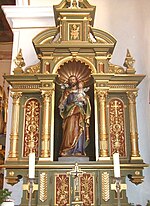Überlingen
1803 disestablishments in the Holy Roman EmpireBadenBodenseekreisEngvarB from July 2022Pages including recorded pronunciations ... and 6 more
Pages with German IPAPopulated places on Lake ConstanceStates and territories disestablished in 1803States and territories established in 1268Swabian LeagueTowns in Baden-Württemberg

Überlingen (German pronunciation: [ˈyːbɐˌlɪŋən] ; Low Alemannic: Iberlinge) is a German city on the northern shore of Lake Constance (Bodensee) in Baden-Württemberg near the border with Switzerland. After the city of Friedrichshafen, it is the second-largest city in the Bodenseekreis (district), and a central point for the outlying communities. Since 1 January 1993, Überlingen has been categorized as a large district city (Große Kreisstadt).
Excerpt from the Wikipedia article Überlingen (License: CC BY-SA 3.0, Authors, Images).Überlingen
Sankt-Ulrich-Straße, Verwaltungsgemeinschaft Überlingen
Geographical coordinates (GPS) Address Nearby Places Show on map
Geographical coordinates (GPS)
| Latitude | Longitude |
|---|---|
| N 47.766666666667 ° | E 9.165 ° |
Address
Sankt-Ulrich-Straße 5
88662 Verwaltungsgemeinschaft Überlingen
Baden-Württemberg, Germany
Open on Google Maps









